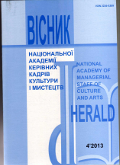Modern historiography Orthodox monasteries and monks Cherkasy region
DOI:
https://doi.org/10.32461/2226-3209.4.2013.138033Keywords:
Historiography, Monasteries, Cherkasy region., monasticism, the cave, the Orthodox Church, historian, researchAbstract
We analyze the development and state of the historiography of the history of research on the issue of Orthodox monasteries and monks in Cherkasy. Study the trends and directions of scientific work. Attention is focused on the most pressing issues that are covered by modern science. Regional history is an integral part of the history of Ukraine. Business History of the Orthodox Church in Ukraine is as projected in local history, as in all-or Eastern European. However, coverage of these processes in the context of historiographic almost non-existent, especially with regard to the development of Ukrainian history in the late XX – early XXI century. In this sense, it is important to pay attention to regional historical science, in particular his views on Orthodox monasteries and monks of Cherkasy region. First of all, it should be noted the uniqueness of Cherkasy region. This peculiarity slightly affects the understanding of modern historiography on the situation in the region. The area was founded in 1954 (under the Decree of the Presidium of the Supreme Soviet of 7 January and 12 February) as a sign commemorating the 300th anniversary of the "reunification" of Ukraine with Russia. Modern scientific research into the history of monasteries Cherkasy region actually began in the late 1980's due to the enthusiasm of local ethnographer J. Marynovskoho. By this time, some publications have appeared in the XIX – early XX century. and single – in the Soviet period. Originally published his pamphlet on the history of the famous explosion Koliivschyny in 1768 Motronynskoho Trinity Monastery, an article about Nicholas Medvedivka monastery. He later became known for publishing a number of documents relating primarily economic and social ties monasteries of the local population. Influenced publications Yu Marynovskoho there work and other researchers, including V. Lastovskogo, L. Stepanov, A. Pashkovskyi. Between them there was cooperation in identifying materials and publications (her butt is pretty extensive publications on the process of elimination of monasteries in Cherkasy region in 1920, although the title listed only the name Yu Marynovskoho , and the names of other researchers noted in the notes). Later, each of the researchers concentrated their attention on a particular monastery. Was in the focus of local scientists and other monasteries. Thus, S. Kryvenko , an employee of the State Archives of Cherkasy region paid much attention to the history of the Church in Cherkassy region during the Soviet period , in particular the activities of monasteries in the 1940 's and 60 's. Many times historians have turned to history and famous Trahtemyrivskyh Kanev and monasteries, which are often associated with the history of the Ukrainian Cossacks, so it is even called "Cossack" (although it is rather a tribute to a certain vogue than actual status). Some attention paid to the monastery Onufrievsky Korsun director Korsun-Shevchenko State Historical and Cultural Reserve P. Stepenkina. It should be noted that after O. Kryzhanivskyi -known work on the socio -economic situation of religious structures on the Right Bank Ukraine (1991) study of participation monasteries in socio-political and socio-economic relations started or specified in relation to eighteenth – nineteenth century. The most thorough study of the history of the closure of monasteries in Cherkasy the publication Yu Marynovskoho back in 1993 on the basis of unpublished materials of the State Archives of Cherkasy region. Since the late 1980s began trying reassessment of information and finding explanations for facts that do not fit into the general scheme of Ukrainian-Polish interfaith relations. In 1990 the transitional phase transformation of scientific approaches have characterized the imitation of Soviet ideology. The well-known Ukrainian researcher OP Kryzhanovsky in 1991 emphasized the negative role of Polish historiography in matters of coverage of the history of the church on the Right Bank Ukraine, while idealizing the activities of Catholic-Uniate clergy. Historians have repeatedly is observed that the life of monasteries Polish factor could influence and very positive. Although this idea was not considered in detail, but it has the right to life, as evidence suggests just the revival of Orthodox monasteries in Right-Bank Ukraine (now under the authority of the Commonwealth ) after the conclusion of the contract Prut, especially in the 1730-40s. However, the emergence of new information and rethinking the past is very slow going in the scientific community, especially Ukrainian. At the same s modern historical thought until this question almost no discussion. Business monasteries Cherkasy region repeatedly linked and cultural processes in the region. The researchers pointed to the close relationship with the Orthodox monasteries population based on the worship of the miraculous icon.Downloads
Published
Issue
Section
License
Authors who publish with this journal agree to the following terms:
1. Authors retain copyright and grant the journal right of first publication with the work simultaneously licensed under a Creative Commons Attribution License International CC-BY that allows others to share the work with an acknowledgement of the work's authorship and initial publication in this journal.
2. Authors are able to enter into separate, additional contractual arrangements for the non-exclusive distribution of the journal's published version of the work (e.g., post it to an institutional repository or publish it in a book), with an acknowledgement of its initial publication in this journal.
3. Authors are permitted and encouraged to post their work online (e.g., in institutional repositories or on their website) prior to and during the submission process, as it can lead to productive exchanges, as well as earlier and greater citation of published work (See The Effect of Open Access).


